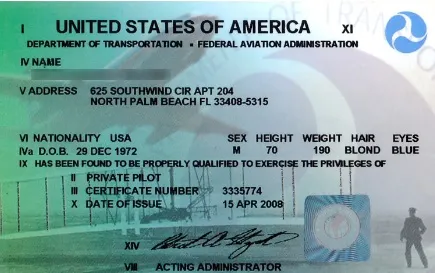Earning a Pilot Certificate

Earning a private pilot certificate is a significant accomplishment that requires a combination of ground school and flight training. The Federal Aviation Administration (FAA) sets the requirements for obtaining a private pilot certificate. The process can vary depending on the individual’s prior experience and the flight school they choose. Here is a general overview of the steps required to earn a private pilot certificate.
Meet the eligibility requirements: In order to be eligible for a private pilot certificate, an individual must be at least 17 years old, able to read, speak, write, and understand the English language, and pass a medical examination, unless you are seeking a sport pilot certificate. A sport pilot does not require a medical review and is a great option for older pilots. The PPL medical examination must be conducted by an FAA-approved medical examiner and must be renewed at one, two, or five years depending on the pilot’s age and medical class needed.
Obtain a student pilot certificate: Before starting flight training, an individual will get a student pilot certificate from the FAA. This can be done by completing an application with your CFI. You will need to have your driver’s license, State ID, and passport for this part of the process.
Complete ground school training: Ground school training is an essential part of the process and covers the theoretical knowledge necessary to safely fly an aircraft. The training includes subjects such as aerodynamics, meteorology, navigation, and regulations. Ground school training can be completed in a traditional classroom setting or through an online program. After ground school, students must complete the written exam:
FAA written exam: Regardless of the license you are seeking, students must pass the knowledge test, which covers basic aeronautical knowledge, weather, navigation, and federal aviation regulations. Each certification has a knowledge test that must be taken at a designated FAA testing center.
Complete flight training: After completing ground school training, an individual must complete a minimum of 40 hours of flight training, which must include at least 20 hours of solo flight time. The flight training includes both basic maneuvers and complex maneuvers such as cross-country navigation, emergency procedures, and night flying. Sport pilots only need to complete 20 hours of flight training, but it should be noted that completing in the minimum time is not typical.
Pass a practical test (Check ride): Once the flight training is completed, an individual must pass a practical test, also known as a check ride. The practical test includes an oral exam and a flight test, which is conducted by an FAA-designated pilot examiner (DPE). The test covers the individual’s knowledge and skills, including takeoff, landing, navigation, and emergency procedures.
Obtain a private pilot certificate: After passing the practical test, an individual will be issued a private pilot certificate, which is valid for life. However, it’s important to keep in mind that the pilot must complete a certain amount of flight hours and pass a flight review every 24 months in order to maintain the certificate. A good pilot is always learning and must stay current.
In conclusion, earning a private pilot certificate requires a combination of ground school and flight training, passing a medical examination, obtaining a student pilot certificate, passing a practical test, and meeting the minimum flight hours requirement set by the FAA. The process can take several months or more to complete, and the cost can vary depending on the flight school and the individual’s prior experience. For those willing to put in the time and effort, the rewards of becoming a private pilot are well worth it.
Ready to start flying? Call or text us today at 757-821-7355.
